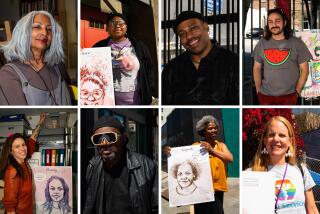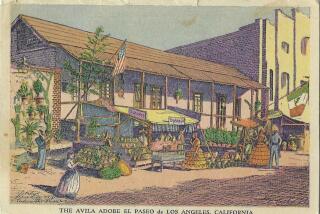Muralist Honors California Indians : Art: Judy Bacaâs $60,000 project to spruce up the Baldwin Park Metrolink rail station puts âmemory into a piece of land.â
Artist Judy Baca did a little dance in Baldwin Park the other day, a very old little dance.
In the dry heat of a midday sun, Baca skipped along a concrete footpath that represents ceremonial steps performed by early California inhabitants, the Gabrielino and Chumash Indians.
The winding lane is part of âDanza Indigenasâ (Indigenous Dances), the public artwork she designed to spruce up the Baldwin Park Metrolink commuter rail station.
âI wanted to put memory into a piece of the landâ that once was home to the American Indian cultures, said the Los Angeles muralist, Latino activist and UC Irvine art professor. She hopes to complete finishing touches over the next two weeks.
Central to Bacaâs design is the 20-foot-high re-creation of an archway from the nearby San Gabriel Mission. Beneath it stretches the missionâs abstracted floor plan, etched into the colored concrete of an open plaza. From it extends the footpath, which links shelters where commuters wait for trains.
*
Located at the corner of Downing Avenue and Ramona Boulevard in the San Gabriel Valley, the $60,000 project is part of the 4-year-old Art for Rail Transit Program instituted by the L.A. County Metropolitan Transportation Authority. To date, 65 artists have been commissioned to adorn stations throughout Southern California.
âWe believe itâs important to make the train system not only efficient but attractive and user-friendly,â said Jessica Cusick, rail-art program director. âItâs also really important to . . . provide communities with a sense of ownership in the stations.â
Baca, who was chosen for the job from among roughly 25 other artists, has been involved in mural-making for about a quarter century. Among her murals is the half-mile-long âGreat Wall of L.A.,â purported to be the worldâs longest. She has overseen creation of about 200 works as a founder of two municipally funded mural programs in Los Angeles.
For the Baldwin Park artwork, she wanted to portray an âauthenticâ and âtruthfulâ vision of the areaâs history.
*
Etched into the weathered adobe-like central arch is the word Sunigna , the Gabrielino name for the area, and a quote from Latino author Gloria Anzaldua: âThis land was Mexican once, was Indian always and is, and will be again.â
Lettering on the plaza floor spells out, in English, the statement: âWhen the Indians died, the villages ended.â
When the Spanish arrived, Baca said, soldiers raped scores of Gabrielino women, including the chiefâs wife. The chiefâs protests led to his decapitation. âIt was in that climate that the Mission San Gabriel was founded,â she said.
A stone mound, like one the Gabrielinos would have designated as a place of prayer, embodies a feminist ideology the artist worked into the project. It is a tribute to Toypurina, a 23-year-old Gabrielino woman who led a revolt against the Spanish missionaries, she said.
âToypurina was depicted (by the Spanish) as a seductress and sorceress because she organized large groups of native people to fight the Mission San Gabriel and bring it down. For that, she was banished from her native land. I felt it was appropriate to put her back into her own territory.â
âDanza Indigenasâ was a collaboration involving Baca and L.A. architects Kate Diamond of Siegel Diamond Architects and Gustavo Leclerc of Adobe L.A. Typical of her mural-making methods, Baca also interviewed Gabrielinos and other residents of Baldwin Park, a largely Latino town of 70,000.
*
âIn the process, I developed a sense of what was going on with the whole place,â she said, and gathered quotes she emblazoned on the archway. Among the residentsâ statements: âIf this place was good enough for me to grow up in, then it is good enough for my childrenâ; âThe kind of community that people dream of, rich and poor, brown, yellow, red, white, all living together.â
To further âpersonalizeâ the train station, Baca imprinted into the concrete beneath each of four shelters (also bearing floor plans of California missions) such phrases as âmy motherâ and âI am a Gabrielino,â rendered in Gabrielino, Chumash, English and Spanish.
At the shelter farthest from the main plaza are the words memory and willpower , which âare what any culture--the ones living then and those living now--has to have to preserve itself,â she said.
So far, community response has reportedly been positive. Children dance along the footpath and people driving by give thumbs up, said Chris Wille, job supervisor with Rock and Water Scapes, the projectâs Irvine-based contractors.
âThey dig it; they think itâs an awful-fancy transit station,â Wille said.
More to Read
Sign up for Essential California
The most important California stories and recommendations in your inbox every morning.
You may occasionally receive promotional content from the Los Angeles Times.










